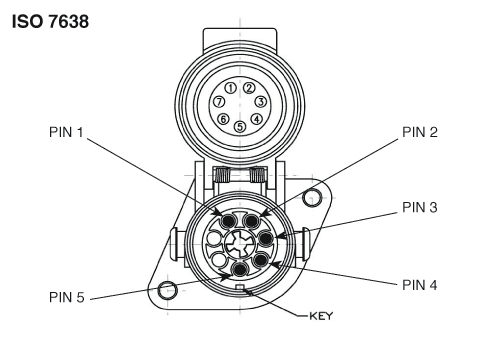How pin 5 works It is often thought that pin 5 is controlled by the truck's ABS system, or, even by the truck itself, both of these are incorrect. How pin 5 actually works is quite simple: Power from the battery via the ignition switch goes to a fuse, then to the warning light in the cab, and then on to pin 5. When the ABS lead is connected to the trailer, the trailer ABS system reads 24 volts coming down pin 5 and then lowers the voltage inside the trailer ecu to below 5 volts (or to ground in some cases), which then brings the ABS light on in the cab. When the vehicle is driven away, and the trailer ABS system is happy with the wheel speed signals, the ECU then raises the voltage back up to 24 volts and the warning light in the cab goes out. If a fault appears when the vehicle is driven, the ECU lowers the voltage again bringing the light back on. Check the power An easy way to check the power from the iso socket is to use a multimeter and test between: - Pins: 1 and 4
- Pins: 2 and 3
- Pins: 4 and 5
You should have three lives and two earths. Alternatively, you could use an ISO tester such as the Drakefield DRA07T to do all these tests for you. In which case, you merely have to plug the DRA07T into the truck, and read the LED display on the side of the unit. Most new trucks don't actually have a warning light as such, instead the dash is an LCD display which shows a picture of a trailer, or trailer warning, but pin 5 still works in the same way. pin 5 is always controlled by the trailer ECU. Pins 6 and 7 The next things to mention are pins 6 and 7 in an EBS lead. These are the "CAN" connections, "CAN" stands for Control Area Network, which in simple terms is a connection between two or more ECUs allowing them to talk to each other. When you have an EBS truck and an EBS trailer, the braking is done through the CAN lines. When you press the brake, the truck sends a CAN signal to the trailer ECU to tell the brakes to apply, if the CAN signal fails, the brakes will still work using the air pressure signal through the service line. Some people have asked me, "If you have an ABS truck and EBS trailer, do the trailer brakes still work properly?" The answer is yes; all it means is the truck is unable to send the CAN signal to the trailer, the brakes, however, will work as normal. Finally, the last thing to mention is that the ABS light should be out. | ![]() What industry people are saying...
What industry people are saying...![]()

